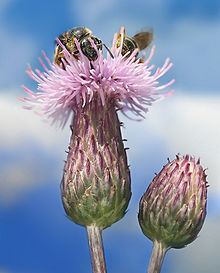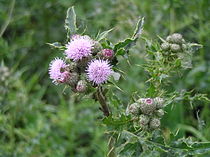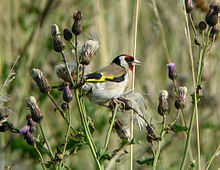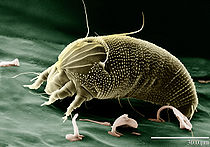- Cirsium arvense
-
"Cursed Thistle" redirects here. For the medicinal plant, see Cnicus.
Cirsium arvense 
Scientific classification Kingdom: Plantae (unranked): Angiosperms (unranked): Eudicots (unranked): Asterids Order: Asterales Family: Asteraceae Tribe: Cynareae Genus: Cirsium Species: C. arvense Binomial name Cirsium arvense
(L.) Scop.Cirsium arvense is a species of Cirsium, native throughout Europe and northern Asia, and widely introduced elsewhere. The standard English name in its native area is Creeping Thistle.[1][2][3]
Contents
Alternate names
A number of other names have been used in the past, or in other areas including: Canada Thistle,[4] Canadian Thistle, California Thistle,[5] Corn Thistle, Cursed Thistle, Field Thistle, Green Thistle, Hard Thistle, Perennial Thistle, Prickly Thistle, Small-flowered Thistle and Way Thistle. The first two names are in wide use in the United States, despite being a misleading designation (it is not of Canadian origin).[6]
Physical characteristics
It is a herbaceous perennial plant growing 30–100 cm, forming extensive clonal colonies from an underground root system that sends up numerous erect stems each spring, reaching 1–1.2 m tall (occasionally more).
Stems are green smooth and glabrous (having no Trichome or glaucousness), mostly without spiny wings. The stems often lie partly flat by summer but can stay erect if supported by other vegetation. The leaves are very spiny, lobed, up to 15–20 cm long and 2–3 cm broad (smaller on the upper part of the flower stem).
The inflorescence is 10–22 mm diameter, pink-purple, with all the florets of similar form (no division into disc and ray florets). The flowers are usually dioecious, but not invariably so, with some plants bearing hermaphrodite flowers. The seeds are 4–5 mm long, with a feathery pappus which assists in wind dispersal.[3][7][8] The plant also spreads underground using rhizomes.
There are two varieties:[3]
- Cirsium arvense var. arvense. Most of Europe. Leaves hairless or thinly hairy beneath.
- Cirsium arvense var. incanum (Fisch.) Ledeb. Southern Europe. Leaves thickly hairy beneath.
As a subclassification of the "Eudicot" monophyletic group, Cirsium is a "true dicotyledon". The number of Pollen grain furrows or pores helps classify the flowering plants, with eudicots having three colpi (tricolpate).[9][10]
C. arvense is a C3 carbon fixation plant.[11] The C3 plants, originated during Mesozoic and Paleozoic eras, and tend to thrive in areas where sunlight intensity is moderate, temperatures are moderate, and ground water is plentiful. C3 plants lose 97% of the water taken up through their roots to transpiration.[12]
It is a Ruderal species.[13]
Ecology
The seeds are an important food for Goldfinch and Linnet, and to a lesser extent for other finches.[14] Creeping Thistle foliage is used as a food by over 20 species of Lepidoptera, including the Painted Lady butterfly and the Engrailed, a species of moth, and several species of aphids.[15][16][17]
Status as a weed
The species is widely considered a weed even where it is native, for example being designated an "injurious weed" in the United Kingdom under the Weeds Act 1959.[18] It is also a serious invasive species in many additional regions where it has been introduced, usually accidentally as a contaminant in cereal crop seeds. It is cited as a noxious weed in several countries; for example Australia, Brazil, Canada, Ireland, New Zealand, and the United States. Many countries regulate this plant, or its parts (i.e., seed) as a contaminant of other imported products such as grains for consumption or seeds for propagation. In Canada, Cirsium arvense is classified as a primary noxious weed seed in the Weed Seeds Order 2005 which applies to Canada's Seeds Regulations.[19]
Control methods include:
- cutting at flower stem extension before the flower buds open to prevent seed spread. Repeated cutting at the same growth stage over several years may "wear down" the plant.
- Applying herbicide: Herbicides dominated by phenoxy compounds (especially MCPA) saw drastic declines in Thistle infestation in Sweden in the 1950s.[11]
Orellia ruficauda feeds on Canada thistle has been reported to be the most effective biological control agent for that plant.[20] Its larvae parasitize the seed heads of the plant feeding solely upon fertile seed heads.[21]
The rust species Puccinia obtegens has shown some promise for controlling Canada thistle, but it must be used in conjunction with other control measures to be effective.[22]
Aceria anthocoptes feeds on this species and is considered to be a good potential biological control agent.
Uses
Like other Cirsium species, the roots are edible, though rarely used, not least due to their propensity to induce flatulence in some people. The taproot is considered the most nutritious. The leaves are also edible, though the spines make their preparation for food too tedious to be worth eating. The stalks, however, are also edible and more easily de-spined.[23]
References
- ^ Joint Nature Conservation Committee: Cirsium arvense
- ^ Botanical Society of the British Isles Database
- ^ a b c Flora of Northwest Europe: Cirsium arvense
- ^ Nebraska Department of Agriculture Noxious Weed Program
- ^ Californian Thistle (Cirsium arvense), Landcare Research, New Zealand
- ^ Invasive and Problem Plants of the United States: Cirsium arvense
- ^ Blamey, M. & Grey-Wilson, C. (1989). Flora of Britain and Northern Europe. ISBN 0-340-40170-2
- ^ Kay, Q. O. N. (1985). Hermaphrodites and subhermaphrodites in a reputedly dioecious plant, Cirsium arvense (L.) Scop. New Phytol. 100: 457-472. Available online (pdf file).
- ^ Kenneth R. Sporne (1972). "Some Observations on the Evolution of Pollen Types in Dicotyledons". New Phytologist 71 (1): 181–185. doi:10.1111/j.1469-8137.1972.tb04826.x. http://www.blackwell-synergy.com/doi/abs/10.1111/j.1469-8137.1972.tb04826.x.
- ^ Walter S. Judd and Richard G. Olmstead (2004). "A survey of tricolpate (eudicot) phylogenetic relationships". American Journal of Botany 91 (10): 1627–1644. doi:10.3732/ajb.91.10.1627. PMID 21652313. (full text)
- ^ a b Weeds and weed management on arable land: an ecological approach Sigurd Håkansson CABI Publishing Series, 2003, ISBN 0851996515
- ^ Raven, J.A.; Edwards, D. (2001). "Roots: evolutionary origins and biogeochemical significance". Journal of Experimental Botany 52 (90001): 381–401. doi:10.1093/jexbot/52.suppl_1.381. PMID 11326045.
- ^ p80
- ^ Cramp, S., & Perrins, C. M. (1994). The Birds of the Western Palearctic. Vol. VIII: Crows to Finches. Oxford University Press, Oxford.
- ^ Finnish Lepidoptera Cirsium arvense
- ^ The Ecology of Commanster: Cirsium arvense
- ^ Ecological Flora of the British Isles: Phytophagous Insects for Cirsium arvense
- ^ DEFRA: Identification of injurious weeds
- ^ Weed Seeds Order 2005, Canada Gazette Part I, Vol. 139, No. 9
- ^ Moore 1975, Maw 1976
- ^ Lalonde
- ^ Turner et al. 1980
- ^ Plants for a Future: Cirsium arvense
- Defra Website on Weed control
- Lowland Grassland Handbook Chapter 7,available in pdf form from Natural England website
External links
- Species Profile- Canada Thistle (Cirsium arvense), National Invasive Species Information Center, United States National Agricultural Library. Lists general information and resources for Canada Thistle.
- Profile: Canada Thistle (Cirsium arvense) Photos, Drawings, Text. (Wild Plants of Winnipeg from Nature Manitoba)
Categories:- Cirsium
- Flora of Asia
- Flora of Europe
- Flora of North America
- Invasive plant species
- Eudicots
Wikimedia Foundation. 2010.



